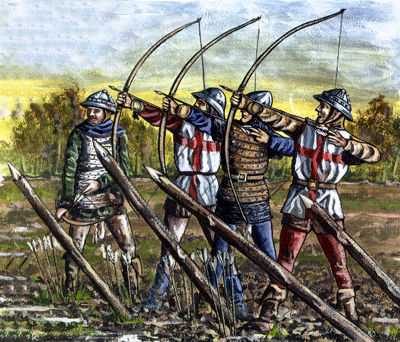
Whether the longbow could penetrate armour or not remains controversial. Attempts to work this out, even by scientific testing, have been complicated by the issue of the draw-weight. Other factors include range, the condition of the bowstrings, the type of arrow in use, and the type of armour worn by the target. Since estimates of the longbow’s performance vary so wildly, any conclusion remains open to challenge.
Despite this, there were occasions on which, according to contemporary accounts, the longbow proved incapable of penetrating armour. At the Battle of Poitiers, Jean Froissart describes the French cavalry as invulnerable to the English arrows, as the front ranks’ horses were wearing metal barding. At the Battle of Flodden in 1513, the chronicler Hall describes the front ranks of the Scottish pikemen as being `assuredly harnessed’, and that they `abode the most dangerous shot of arrows’.
Nonetheless, Poitiers and Flodden were English victories. When faced with armour immune to their favourite weapon, the English response was often a swift change in tactics. At Poitiers, the archers responded by moving to either side of the oncoming French cavalry and shooting into their more vulnerable flanks. Not only did the metal barding offer less protection, but this also allowed the archers to shoot at any unprotected horses in the ranks behind.
This was neither the first nor the last time that English archers adopted this tactic. The same had been attempted at the Battle of the Bannockburn in 1314, only for the enterprising archers to be ridden down by Scottish cavalry. At Formigny, the English had been winning the battle until the arrival of the Breton cavalry from the south. Though they could do little against the Scottish pikemen at Flodden, the archers of Sir Edward Stanley’s division were nevertheless able to drive off the Scottish reserve, consisting of lightly armoured Highlanders.
The limits of protection
But if the longbow was actually incapable of penetrating increasingly sophisticated armour, why was it not abandoned sooner? One answer is that the longbow could still inflict harm on heavy cavalry in many circumstances.
Although French knights and men-at-arms were increasingly wearing protective plate armour by the last decades of the 14th and the first of the 15th century, their horses were not always so fortunate. Sheer expense made metal barding comparatively unusual, with horse armour generally consisting of a cloth caparison or trapper, sometimes over a quilted gambeson. Under a hail of arrows, moreover, the horses were larger and therefore more vulnerable targets than their riders.
At Agincourt wounded French horses stampeded through their own lines, wreaking havoc on the infantry. A more serious wound could cause the horse to fall, trapping or crushing the rider. Worst of all, falling horses could trip those behind and throw an entire charge into chaos.
Effective all-round protection, on the other hand, created its own problem: men and horses so encumbered with plate that they became slow and ponderous on the battlefield. No small part of the archer’s role was to constrict the mobility, flexibility, and weapon-handling of the opposing men-at-arms.
A crisis of the yeomanry?
In the end, the longbow was abandoned as much due to changes in society and popular attitudes as to the exigencies of the battlefield. Reliance on the yeomen as a social group to provide archers contributed to the decline.
Some 16th-century commentators blamed the increase in sheep farming, claiming that ploughmen made the best archers due to their great strength. The idea of the sturdy English peasant as better-fed and healthier than his French counterpart is somewhat exaggerated, but the physical fitness of archers was nonetheless an issue.
A spate of epidemics in the middle of the century, including the infamous `sweating sickness’, combined with increasing food prices, meant that archers were not as healthy or well-fed as they might have been, leading to poorer performance. At around the same time, it was becoming increasingly difficult for would-be archers to afford longbows, as the price of yew staves rose. The reality of a shrunken pool of recruits merged with the perception that English archers, and English manhood in general, were just not up to the standard of their forebears.